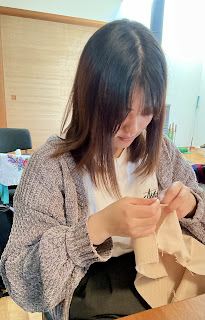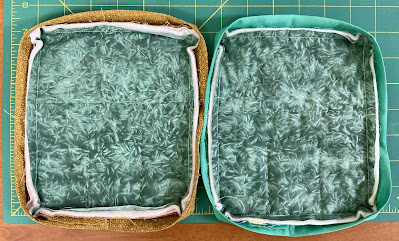Pages
- Home
- Kumano Kodo Trip
- Japanese Festivals
- Japanese Castles
- Stitching Finishes 2025
- Stitching Finishes 2024
- Stitching Finishes 2022
- Stitching Finishes 2021
- Stitching Finishes 2020
- Finish It in 2019
- Stitching Finishes 2018
- Stitching Finishes 2017
- Stitching Finishes 2016
- Stitching Finishes 2015
- Stitching Finishes 2014
- Stitching Finishes 2013
- Stitching Finishes 2012
- Smalls Stitch A Long 2018 - 2019
- Smalls Stitch A Long 2014 - 2017
- 6 & 6 in 2018
- 17 in 2017
- Take A Stitch Tuesday
- English Paper Piecing Projects
Thursday, November 30, 2023
Wednesday, November 29, 2023
Work In Progress Wednesday
I finished the stitching on this pillow and need a pillow form for it. I checked at the closest fabric store to where I live, but they didn't have the size I want. The store clerk suggesting regular loose fiberfil, but I don't want it to look lumpy. I will check another fabric store to try to find the size I want.
Tuesday, November 28, 2023
Stitch Group Sunday - Starting the Japanese Hangings
Another fun afternoon with my stitching friends!
First some show and tell from the last project - drawn thread and chicken scratch.
I had already started my Japanese Hanging, but the rest of the group was starting on Sunday.
Here is what they did during our get together. We are using kimono and obi cuts for these hangings. We will meet again next month to continue.
Tea and sweets
Until we meet again...
Monday, November 27, 2023
Monday Morning Star Count - 135 and 3 Rows
Seven new hexagon flowers for a total of 135.
I have connected three rows of 12 flowers.
I think I have enough flowers made for about eight more rows. Not enough! Until next week...
Sunday, November 26, 2023
Japanese Textile Artist Konekono Kitsune
It is easy to get lost on the internet looking at interesting embroidery. Here is another -
(I won't be able to look at vegetables the same way again.)
Saturday, November 25, 2023
The Self Check Out Gadgets at the Grocery Store
At the grocery store where I regularly shop, there are gadgets like these that shoppers can use to scan their own items. (This photo is from the internet, but my store has the same kind of set up.) I have not used them myself, but I see many Japanese people at my store using them. After scanning the items and putting them in the shopping basket, the shoppers go to a self checkout area with no live cashiers to scan their gadgets, then pay by cash, credit card, or smart phone.
Since I have never tried them, I don't know if the gadgets are more convenient or if they save the shopper time. Maybe they save the store money. Or it might be that there is a shortage of workers for the cashier jobs.
I take my basket to a live person cashier, who scans my items and directs me to a pay machine that takes my cash and spits out a receipt. I understand how this works, so that is what I do. The cashiers greet me and seem to recognize me. Sometimes they tell me things, like if I spend another 50 yen, my eggs will be half price that day. They know I can't read the sign next to the eggs. I appreciate their letting me practice speaking Japanese without laughing at me. I'm not in a hurry and I like the interaction with the store workers.
Do you have these store scanners where you live? Do you use them?
Friday, November 24, 2023
Smalls SAL for November - 2023
Thank You, Mary (at Mary's Thread) for hosting this link up. If you also want to join, check out this page on Mary's blog to find out how.
This month, I finished the Lizzie Kate freebie called Give Thanks. The chart can be found here.
Thursday, November 23, 2023
Separate Thanksgiving Celebrations for Republican and Democratic States
Today is the American holiday, Thanksgiving. To tell the truth, I am very thankful not to be in the United States today. I am sick about what is happening in the country I once thought of as mine. Who could have imagined in 1939 when the big problem was which Thursday to celebrate Thanksgiving that there would be the big division between the political parties there is now?
I have many things to be thankful for every day, not just the fourth Thursday in November. For me, life is good.
Please read this interesting article about which day to celebrate the holiday, which comes from atlasobscura.com and is by Anne Ewbank, written in 2017.
IN 1939, PRESIDENT FRANKLIN DELANO Roosevelt faced a dilemma. He was responsible for declaring the last Thursday of November to be a day of Thanksgiving—something American presidents had done since Abraham Lincoln began the tradition. But November of 1939 had five Thursdays, which would shorten the holiday shopping season. Retailers still struggling from the Great Depression encouraged him to move Thanksgiving earlier by a week. To the country’s shock, Roosevelt agreed. For the next three years, some states recognized the federal government’s new Thanksgiving date, while others defiantly stuck with the old one.
Roosevelt had rejected previous requests to change the date of Thanksgiving, fearing that he would foil local plans and disrupt football schedules. But according to The New York Times, due to the urging of “department stores, general stores, small stores, and almost every kind of store,” Roosevelt announced on April 14, 1939, that Thanksgiving would be on November 23 instead of the expected November 30.
Angry Americans sent Roosevelt thousands of letters and telegrams about the breach of tradition and their disrupted schedules. An anguished calendar maker from Salem, Ohio, wrote in a letter to the White House that the decision would cause “untold grief” in the industry, since 1939 calendars and many 1940 calendars had already been printed. Just as the White House had predicted, football schedules were scrambled, leading some coaches to vow to vote Republican.
Things quickly became partisan. Several states ignored the presidential proclamation due to tradition or convenience, and others ignored it to snub Roosevelt, a Democrat. This muddled schedules even more. A girl in a New York boarding school wrote Roosevelt on October 18 that her home state, Republican-governed Connecticut, was celebrating Thanksgiving on the later date, making it impossible to go home for the holiday.
In 1939, 22 states celebrated Thanksgiving on the new date, and 23 on the old. But Texas, Colorado, and Mississippi took the best approach: They celebrated Thanksgiving on both dates. Many Americans did the same. In New York City, which celebrated the earlier date, restaurants offered turkey dinners on the “old” Thanksgiving date, too.
Journalists and politicians invented names to mark the confusion. The mayor of Atlantic City called the new date “Franksgiving,” which stuck. Others used the moniker “Democratic Thanksgiving” or “New Deal Thanksgiving,” describing it as another example of the president inappropriately flexing his executive powers.
People were still confused a year later. In 1940, a restaurant sent a telegram to the White House: “CONGRATULATIONS ON YOUR REELECTION. WHEN SHALL WE SERVE OUR THANKSGIVING TURKEY 21ST? OR 28TH?” Only 32 states ultimately celebrated on the new Thanksgiving date. After a survey of 200 stores depicted no real economic benefit, Roosevelt announced that 1942’s Thanksgiving would be held on the original, traditional date.
The president seemed to find his failed Franksgiving experiment funny. The New York Times reported that he seemed lighthearted at the press conference, which was supposed to be about wartime foreign policy. But Congress was less jolly. In October of 1941, the House passed a resolution to make Thanksgiving a public holiday, celebrated on the last Thursday of November regardless of presidential proclamation.
But the resolution was amended when it got to the Senate. Thanksgiving would be celebrated on the fourth Thursday. That way, most Thanksgivings would happen on the last Thursday, without cutting the holiday season short in other years. Still, some states held onto the last-Thursday date for years, sustaining the sense of confusion. In the 1942 movie Holiday Inn, which starred Bing Crosby and Fred Astaire, an animated scene shows a turkey hopping between two potential dates before giving up with a shrug.
And the two-Thanksgivings phenomenon didn’t end there. In 1944, which featured another five-Thursday November, Florida, Idaho, Nebraska, Texas, Virginia, and Tennessee all celebrated a week after the rest of the country. Texas was the last holdout, observing Thanksgiving on the last Thursday until 1956. Today, Americans all celebrate on the same date, without waiting for a presidential proclamation. In 2017, that’s probably a good thing, because President Trump might have kept the country in suspense.
Wednesday, November 22, 2023
Work In Progress Wednesday
New start
New start - Japanese Hanging (stitch group project)
Floral Pillow Cover progress
Kogin progress
Tuesday, November 21, 2023
Japanese Artist, Hosanna Hirano
Lin, who blogs at St. Victor Quilt introduced me to Hosanna Hirano. (Thank you Lin!)
I'm not on instagram, but if you are, you can check her out at @towelket_tokyo
You can also see more at the website here.
Monday, November 20, 2023
Monday Morning Star Count - 128 and Starting to Connect
Eight new ones for a total of 128.
I started to join the hexagon flowers (right side in photo below).
I still need to make many more flowers!
Sunday, November 19, 2023
Japanese Embroidery Artist Narumi Takada
Saturday, November 18, 2023
Rising Elderly Nursing Costs
Japanese people are among the longest living people on the planet. With people living longer, more elderly care is needed.
According to statistics on long-term care benefit expenditures for fiscal 2022, the cost of resident nursing care services increased 158.6 billion yen year on year to 10.9 trillion yen. Preventive care for those with less serious conditions rose by 3.4 billion yen to 283.1 billion.
The average annual cost per care recipient was 203,100 yen, an increase of 3,500 yen. The average cost of preventative care for those not requiring resident care was 27,900 yen. (source - Ministry of Health, Labor, and Welfare)
By prefecture, the highest average expenditure was 223,700 yen in Tottori, followed by 216,100 yen in Okinawa, and 216,100 yen in Ishikawa. In fiscal 2022, the total number of those requiring resident nursing care rose by 123,000 year on year or 2.2%.
The number of recipients of nursing care or home support as of April 2023 was 7.2 million, and increase of 60,000 year on year. The number recieving resident nursing care in that same time was 5.5 million, a year on year increase of 100,000. Women outnumber men at 3.8 million to 1.7 million. In-home support services recipients were the largest number of users (3.9 million), equipment rental (2.8 million), outpatient day care (1.6 million), and home visits (also 1.6 million).
Japan's mandatory LTCI (Long Term Care Insurance), that every person 40 and over into, was started in 2000. The amount of the premium is based on income. Everyone, regardless of income, has the same benefits. Benefits can be accessed starting at age 65 and all services require a 10% co-pay.
I imagine elderly care is expensive everywhere, but I wonder about how other countries compare with Japan.
Friday, November 17, 2023
Friday Finishes - Two Coasters and a Mini-bag
Using two small houses left over from the center of the House Quilt, I made two coasters.
I finished this cute Lizzie Kate (free) design into a self lining drawstring bag.
Thursday, November 16, 2023
The Wanderful Train

















































